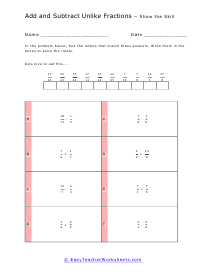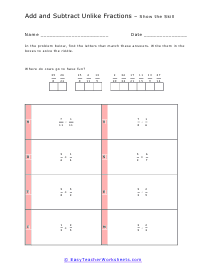This is a solid helping of sum and difference problems using fractions only. The most important thing to remember is that you cannot really attempt anything until get those base numbers (denominators) in the same hemisphere, you get my drift. Once that is complete, it is a totally downhill battle. The fun part of this whole section can be found about mid-way down this page. See what you think.
How do you add and subtract fractions? Fractions are numbers that represent a portion of a whole number. There are two types of fractions, and these include proper fractions and improper fractions. Proper fractions are those that lie between 0 and 1. The denominator of such fractions is greater than the numerators. Improper fractions are those that have a value greater than 1. The denominator of these fractions is lesser than the numerator.
Whether it's a proper fraction or an improper fraction, adding and subtraction is pretty simple. Follow these simple steps to understand the concept better.
Step 1: Identify the Type of Fraction - The first step is to identify the type of fraction, whether they are like-fractions on unlike-fractions. Like-fractions are those that have the same denominators, and unlike-fractions are those that have different denominators.
Step 2: Taking LCM - The next step after you identify the type of fraction is taking the LCM, it is a step that you have to take when you are dealing with unlike fractions. Two fractions can only be added or subtracted if their denominators are the same.
You have to find the LCM of the denominators. Multiply each fraction with a number than can help you turn an unlike-fraction into a like-fraction. The number you choose to multiply the denominator with, you need to multiply the same number to the numerator.
Skip this step if you are dealing with like fractions. Step 3: Start Solving - Once you have obtained the same denominators, you can take out the common fraction 1/(same denominator)(add or subtract the numerators). These worksheets explain how to add and subtract fractions and simplify the answer. Your students will use these sheets to practice adding and subtracting simple fractions.



















